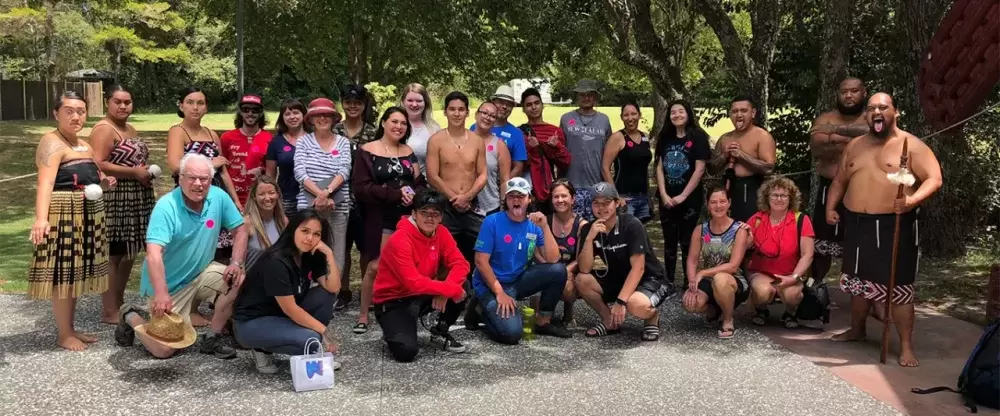A group of Nuu-chah-nulth youth have returned from a trip to New Zealand with a unique perspective of the country’s Indigenous Polynesian people.
The Paddling Beyond trip, organized by the Nanaimo Aboriginal Centre, was planned to expose 11 Aboriginal youth, half of which are Nuu-cha-nulth, to Maori culture. For many of the youth this trip was the first time boarding a plane and travelling outside the province.
Fifteen-year-old Cassidy Fuller, who is Cree and Heiltsuk, said learning about the Maori people and their culture stood out for her on the trip. Although Fuller thought the Maori culture was quite different from her own, some similarities she noted was the way both showed great respect for the environment and each other.
During the 10-day trip the youth and 12 adult chaperones had a full itinerary, which included visiting Ninety Mile Beach on the western coast of New Zealand, paddling in a double-haul canoe, checking out the Hobbiton movie set - which was the location used for the Lord of the Rings film trilogy - and going on a harbour cruise to see dolphins.
The group spent four days at two different Maori communities where they were shown weaving with flax, which is similar to Nuu-chah-nulth cedar bark weaving, and exposed to Maori song and dance.
Seventeen-year-old Huu-ay-aht member Dorion Sutherland remembers performing a prayer song for the Maori people that was gifted to the youth to take to New Zealand by Greg Charleson.
The boys on the trip learnt the Haka—a ceremonial dance, or challenge, in Maori culture—and the girls learnt how to use a musical instrument called a poi.
“They got to learn some of [the Maori] songs and a lot of their protocol,” said Wendy Beaton, teacher at Tsawalk Learning Centre who attended the trip. “Music was huge in the culture.”
During their visit to the Maori, the youth stayed in longhouses that are similar to those used by Nuu-chah-nulth-aht, except they don’t have a fire pit in the middle.
“The walls had totems and the [Maori] ancestors are represented all throughout the design of the building,” Beaton said. “In both of the Maoris they had pictures of their ancestors on the walls so [the youth] had to be respectful and not take pictures. There was a lot of focus on respecting ancestors.”
Fuller pointed out that a highlight of the trip was stopping at a 36-foot totem pole in Auckland that was carved by Nuu-chah-nulth artist Tim Paul. The pole was brought to New Zealand in 1990 for the Commonwealth Games.
“The kids did the prayer song there,” Beaton said. “I think that was a real powerful moment for them. I think there was some real emotion there to know that there was that connection to their territory.”
The group also visited two cultural centres, one in the north and one in Rotoroa in the Auckland Region, that Beaton said gave the youth a “full on cultural experience.”
“The thing that really struck us was the cultural centres that they have are all run by the Maori people and all the money that they collect for admission fees goes into scholarship and into supporting the cultural centre…it’s actually going into rebuilding their culture,” Beaton said. “They have a school at their cultural centre where they’re learning to do their weaving and carving. They give scholarships to all parts of their tribes and take students each year that attend for two years to learn their craft.”
Something else that stood out for Beaton was the resilience and strength of the Maori culture and the steps they have taken to grow.
“I loved that the street names and the cities all seemed to be in the Maori language. Language is very prominent and I think that’s due to the fact they only have the one language,” she said.
Beaton said the youth and chaperones all felt an instant connection to the Maori people they met. They were very welcoming and open about sharing their history and struggles.
“They seemed to be able to look back in a positive way. It seems like the Indigenous people and the non-Indigenous people have found a way to keep the culture strong by working together,” she said.
After returning home from New Zealand, the youth got together to reflect on the trip.
“We were talking about how they have grown as learners,” Beaton said. “We did circle just about every day and [the youth] would have to share their thoughts and feelings about being away from their family, but also this strong sense that they were creating a new family. When we asked the youth about how they felt about learning about a new culture, a lot of them felt like they really wanted to learn more about their own culture…it was very beautiful.”







